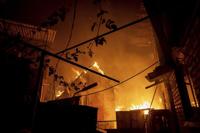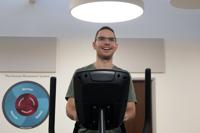COLUMBUS, Ohio (AP) — A high-stakes August special election with national political implications is upending local election offices across Ohio, as already stressed election workers are suddenly faced with a mountain of logistical challenges after Republican lawmakers backtracked on their own law.
Officials have to lure poll workers away from vacations, relocate polling places booked for summer weddings, maintenance or other events, and repeatedly retest ballot language after the .
“It’s disheartening. It's exhausting,” said Michelle Wilcox, a Democrat who is the director of elections in tiny Auglaize County in northwest Ohio. “When you’re overworked, haven't had breaks, are stressed, things can happen. These are the things that lead up to catastrophes on Election Day, and to have to do it on such a short timeline is troubling."
The tight timeframe was imposed by Republican lawmakers, who reversed a new law that had taken effect to eliminate most August elections. In May, they added the Aug. 8 special election for a measure that seeks to . If passed, the amendment would raise the threshold for passing future constitutional changes from a simple majority, as it's been for more than a century, to 60%.
Republicans' immediate goal is to make it harder for voters to pass an that is in the works for November.
Other brewing constitutional amendments also could be affected, including efforts to , increase the , reform and limit .
All of Ohio’s living , both Democrats and Republicans, and five bipartisan former attorneys general , along with a of labor, faith, voting rights, civil rights and community groups. It's of powerful anti-abortion, gun rights, farming and business groups.
Chris Melody Fields Figueredo, executive director of the Ballot Initiative Strategy Center, said the effort is part of a to weaken citizens' access to direct democracy and will have national implications.
“What happens in Ohio, win or lose, will have an impact moving forward and have a reverberating effect across the country, because it's stuck between two major election years, and it's a special election," she said. "Whatever happens, it will set the tone for how we go into 2024 legislative sessions, what tactics, what nuances state legislatures may do to try and undermine the will of the people, and impact the ability of citizens to bring issues to the ballot.”
Despite the significance, August's Issue 1 could be decided by a fraction of Ohio voters. Turnout predictions diverge wildly.
Republican Joe Kuhn, a member of the Auglaize County Board of Elections, said the question should go before voters in a regular general election when history suggests turnout would be greater.
“This goes well beyond the abortion-reproductive rights issue that’s going to hit in November. This affects every other issue that would touch the Ohio Constitution. The law's been in place since 1912,” he said.
Military and overseas voting began Friday, and voter registration closes July 10. Early voting begins the next day.
Chronically low turnouts were among the reasons Ohio nixed August elections in the first place. Republican Secretary of State Frank LaRose testified at the time that they were bad for taxpayers, election officials and the civic health of the state, largely because few people show up.
“That means just a handful of voters end up making big decisions. The side that wins is often the one that has a vested interest in the passage of the issue up for consideration,” he told senators last year. “This isn’t how democracy is supposed to work.”
A group of Republican lawmakers refused to reverse course on the issue, as LaRose since has, preventing passage of a bill that would have reinstated an August election one time and provide $20 million to run it.
Legislative leaders decided the bill wasn't needed, tucking the special election date into the resolution that sent Issue 1 to the ballot without the money to pay for it. One Person One Vote, the opposition campaign, challenged the move as illegal, but .
The money has been included in the state budget bill, but Wilcox, the Auglaize election director, said the absence of available money has created another set of time-consuming tasks for election boards. That includes clearing expenses with county commissioners that would normally be part of their annual budgets and filing tedious reimbursement paperwork.
In addition, she said, contracts with polling places didn't include the August election date. That means postcards will have to go out telling voters of the relocations, then again in the fall reminding them to return to where they normally vote. She said her roughly 45,000-population county barely dodged a problem at the local fairgrounds, which hosts 10 polling locations serving about 9,000 voters.
In populous Cuyahoga County, which includes Cleveland, “a couple dozen” polling locations had to be switched, said spokesperson Mike West. They include churches now booked with weddings and school buildings being renovated.
Aaron Sellers, spokesperson for the Franklin County Board of Elections in Columbus, said the county will use only 282 voting locations, rather than its usual 307, displacing about 7% of voters.
“We had 25 locations that could not accommodate us, due to resurfacing floors, church camps, Bible studies, those types of things,” he said.
To attract people who might be planning August vacations, Franklin County voted this month to increase pay for its poll workers. Sellers said the $134 stipend for working Election Day is set by the state, but the county election board was able to bump poll workers' allowances for training time and set-up duties.
Hamilton County Elections Director Sherry Poland said her office in Cincinnati only had three polling locations with conflicts, leaving poll worker recruitment as its biggest challenge. Commissioners voted last year to give county workers the day off if they serve, without needing to use vacation time, as well as an extra day off, she said, so they are focusing on that group first.
Changing ballot language has been another challenge for local election boards. Initial wording approved by the state ballot board was found to be erroneous by the Ohio Supreme Court, which ordered it rewritten. Wilcox said that's meant testing voting systems multiple times to accommodate the wording changes.
Wilcox said her county's three-person office has been struggling. At one point, the office was juggling duties related to four separate elections: an audit of spring results, the August election, petitions rolling in for the November ballot issue, and the first 2024 candidates beginning to declare their candidacies.
Added to that, groups advancing the abortion rights measure for the November ballot are aiming to collect 700,000 signatures. They're due to local elections offices by July 5.








































